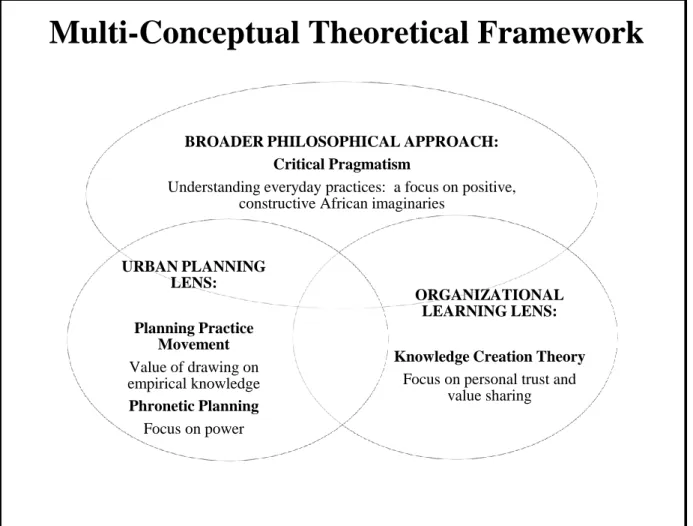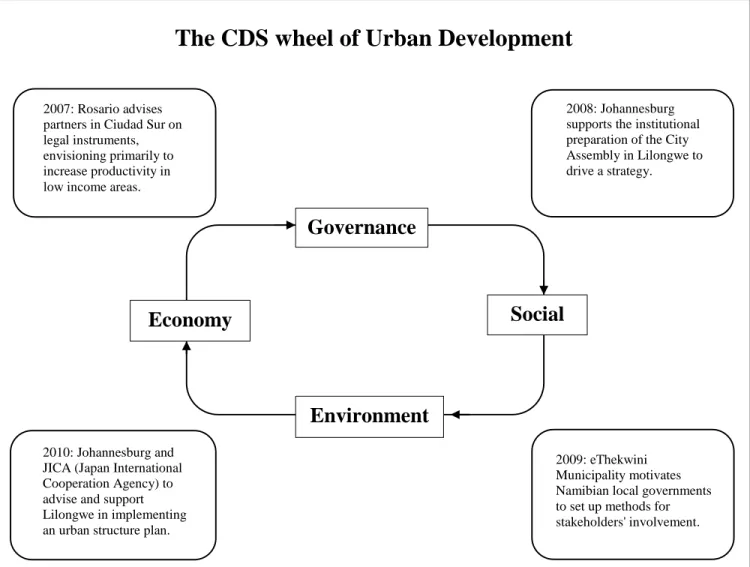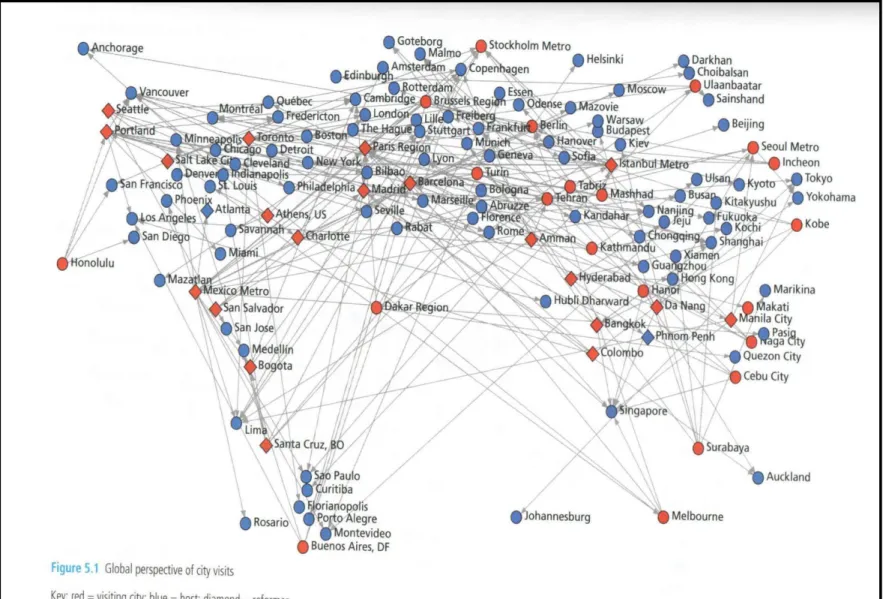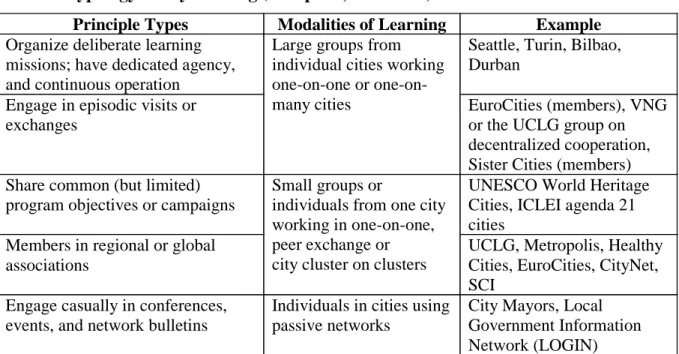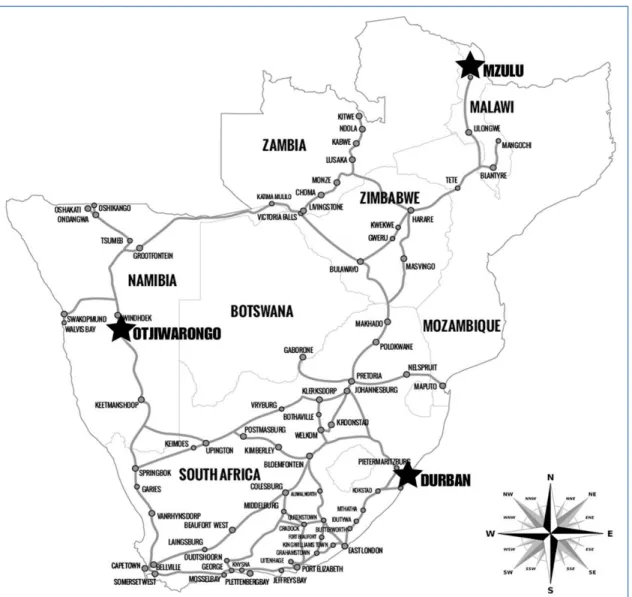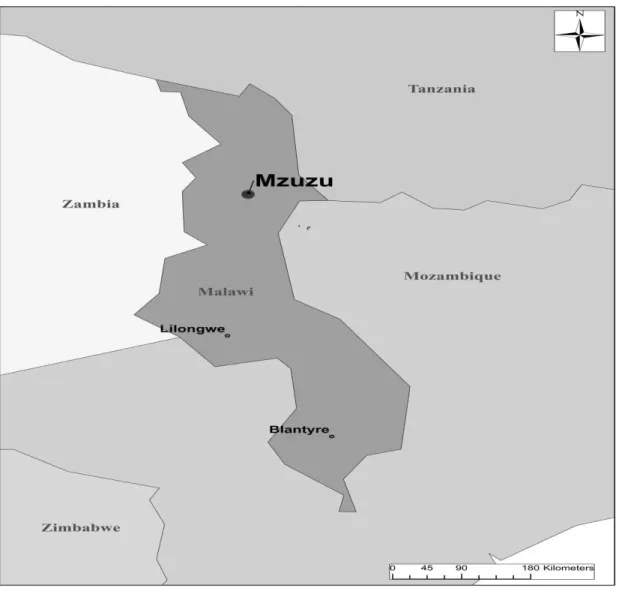To the United Cities and Local Government (UCLG) World Secretariat in Barcelona, and in particular Sara Hoeflich, whose passion for city-to-city learning has been inspiring, thank you for giving me the space for very critical reflection on the program of UCLG mentoring. Most importantly, a learning model has been developed with five clearly defined stages in the city-to-city learning process.
LIST OF TABLES
LIST OF ABBREVIATIONS
SMILE - Swakopmund Municipal Institute of Learning SPSS 21 - Statistical Package for Social Sciences SWAPO - People's Organization of South West Africa SWOT - Strengths/Weaknesses/Opportunities/Threats.
CHAPTER ONE INTRODUCTION
- Setting the scene
- Discussion of research problem and motivation for the study
- Research aim and objectives
- Research aim
- Research objectives
- Guiding research question and key sub-questions
- Research question
- Research sub-questions The five research sub-questions are
- Summary of the research methodology
- Thesis structure and chapter sequence
To measure the effectiveness of site-to-site learning processes in a selected UCLG programme. To propose key elements of an enabling policy framework that can guide more effective city-to-city learning practices in urban strategic planning.
CONCEPTUAL FRAMEWORK
Introduction: the power of multiple lenses
Beyond meta-theory: the move to pragmatism
Multi-Conceptual Theoretical Framework
Planning theory: from communicative planning theory to phronetic planning
As a practitioner, it has been interesting to note the acceptance of the clear boundaries of planning theory in contemporary planning literature. Flyvbjerg (2004) initially argues that the rationalism that is typical of most schools of planning must be abandoned.
Organizational learning and knowledge creation: Towards a geography of learning
Key proponents of knowledge creation theory such as Nonaka (1994) and Sawhney and Prandelli (2000) recognize the intertwined nature of three components: (i) knowledge processes, (ii) knowledge assets and (iii) context. Nonaka and von Krogh (2009) recognize that the process of organizational knowledge creation involves strengthening knowledge in social contexts, and selectively linking it to existing knowledge in the organization.
Summary
CHAPTER THREE LITERATURE REVIEW
Introduction
After seeking this conceptual clarity, a quick history of the rise of city-to-city learning is presented. This is followed by a more detailed unpacking of the actual mechanics of city-to-city learning, as highlighted in the learning literature.
The call for a “new urban agenda”
It also speaks to the nature of urban strategic planning processes in African cities and whether they are powerful and focused enough to bring about the transformation envisaged – the focus of the second thematic area in this literature review. This aspect of city-to-city learning is the focus of the second thematic area in the review.
The rise of urban strategic planning and the role of city visioning
This, it is argued, is a useful conceptualization of the CDS process, emphasizing the opportunity for a critical engagement with what makes a city unique and distinctive and how these can be leveraged to achieve particular development outcomes. The importance of active citizen involvement in urban strategic planning not only contributes to the dynamism of the city, as Robinson (2007) suggests, but is also well documented in the literature.
Governance
Despite this arguably limited conceptualization mentioned above, the emphasis on decision-making around setting priorities in the formulation of a long-term development city vision is important and useful. An urban vision is best understood as a process that depicts an idealized situation and is represented through a set of goals for the future (Baud et al., 2014).
Social
This is a fundamentally important step and it is now recognized that stakeholders' visions of the future city have indeed played a key role.
Environment Economy
The CDS wheel of Urban Development
- Defining city-to-city learning
- A brief history of city-to-city learning
- Unpacking the mechanics of city-to-city learning: the importance of trust and human relationships in the knowledge economy
- Power, geo-politics and city mentorship: the role of key stakeholders in international city-to-city learning
For example, the notion of city-to-city learning was clearly reinforced by the idea of. Unraveling the mechanics of city-to-city learning: the importance of trust and human relations in the knowledge economy and human relations in the knowledge economy. To summarize, the following key points stand out from a review of the mechanics of learning from the city-to-city literature.
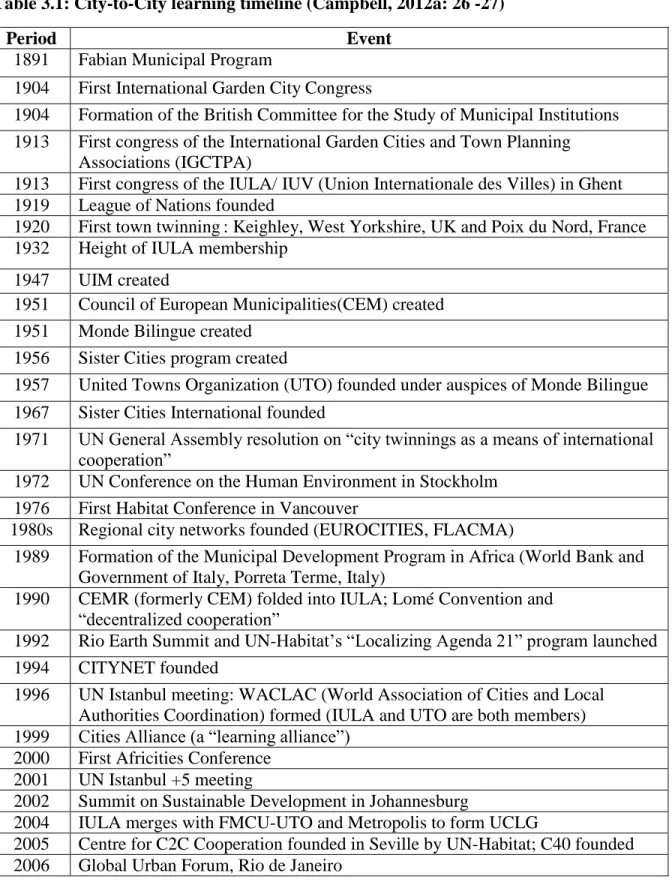
The impact of city-to-city learning on strategic planning practice
- Guidelines for assessing the effectiveness of city-to-city learning
Dolowitz and Marsh's (2000) study was important at the time because it recognized that policy transfer studies accepted that such transfer processes led or would lead to the successful implementation of the respective policy. Essentially, as part of the framework, they ask six key questions that are reiterated here (Dolowitz & Marsh). It is also interesting to note that De Villiers acknowledges that more research is needed to establish the context in which the framework can be applied, noting the differences due to “geographical orientation of relationships, city size, resources employed and the size of the relationship portfolio”.
Summary and key conclusions emerging from the literature
How exactly this learning process between cities unfolds formed the basis of the third thematic area in this chapter. A quick journey through time was then taken to review the history of the emergence of city-to-city learning, followed by a more detailed exposition of the actual mechanisms of city-to-city learning as highlighted in the learning literature. The issue of trust and human relationships in urban learning processes was identified as a very important theme to be empirically tested in the case study.
CHAPTER FOUR
THE STUDY AREA AND RESEARCH METHODOLOGY
Introduction
The UCLG mentorship program: The case study of eThekwini Municipality, Durban as mentor and Otjiwarongo, Namibia and Mzuzu,
- Background to the UCLG mentorship program
- The eThekwini Municipality, Durban, South Africa
- An overview of the eThekwini Municipal area
The former city manager of the eThekwini Municipality, in his capacity as the co-chair of the UCLG USPC, wrote the rationale for the UCLG mentorship programme. In contextualising the mentoring project it is also useful to point out that in addition to the program management role played by the UCLG, there are Local Government Associations in each of the respective cities which play a support role and the Cities Alliance which is the program funder, which is also an important player in the process. More details about case study research and its benefits will be returned to in the second part of this chapter, where a fuller consideration of the research methods is undertaken.
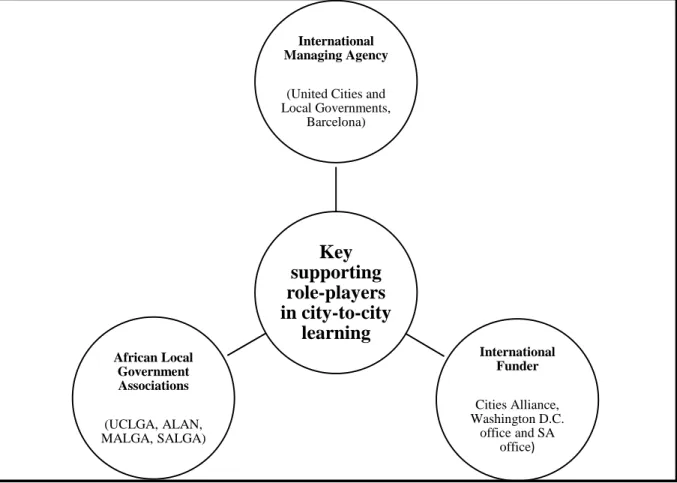
June 2013
- Background to eThekwini Municipality’s strategic planning process
- Mzuzu City, Malawi
- Background to the Mzuzu Council Area
- The strategic planning process in Mzuzu
- City mentorship in Namibia
- Setting the development context in Namibia
- Background to the CDS process in Namibia
- Otjiwarongo: Lead pilot municipality in CDS/ Town Development Strategy (TDS) process
- Research approach and design
- Research methods
- Document and textual content analysis
- Focus group discussions
- Key informant interviews
- Field observations
- Census survey
- Some key methodological considerations
- Summary
In this section, a brief summary of eThekwini Municipality's profile and the defining characteristics of its strategic planning process is provided. In this mentoring program with the eThekwini municipality, the local process facilitation support has been provided by NALAO, unlike the case of Malawi. The quantitative phase two of the study is what will be outlined in the next section.
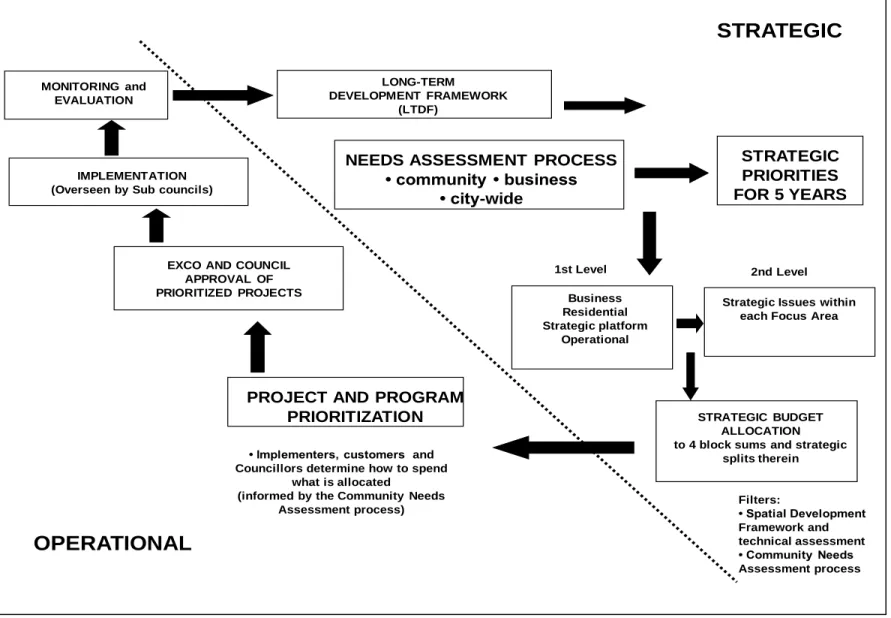
CHAPTER FIVE
THEMATIC ANALYSIS: GETTING TO GRIPS WITH CITY-TO-CITY LEARNING
Introduction
The fourth and fifth areas of analysis regarding city-to-city learning policy and program impact are discussed separately in the next chapter. Broadly speaking, as a structuring mechanism for these two chapters, each thematic area begins with a summary of findings emerging from the eThekwini municipality focus group workshop, made up of planners and facilitators responsible for 'mentoring' their Namibian and Malawian counterparts. These insights from practitioners involved in the mentoring program are then complemented by findings that emerged from a survey conducted with respondents who participated in the Otjiwarongo and Mzuzu stakeholder visioning workshops.
Overview of the demographic profile of respondents
Before starting the thematic analysis, it is important to present an overview of the profile of all key interviewees and respondents who participated in the census survey in both cities. Once again, the need for greater involvement of younger people will be emphasized when making recommendations for deepening inclusion in the program. The level of education of the census survey respondents in Otjiwarongo and Mzuzu City Council as shown in Table 5.5 showed differences between the two cities.

- A long-term planning horizon
- Participatory planning rather than merely consultative
- An integrated and holistic approach to development
- Strategy that translates into action
- Joint ownership of plan
In analyzing the different responses from across the research participants, five common features of the eThekwini Municipality's planning process were distilled as a case of good practice. This was explored during the focus group interview with the eThekwini Municipality's planners who were architects of the process. It is also worth pointing out that the majority of respondents (82%) either agreed or strongly agreed with the idea of the eThekwini Municipality's planning process as a strategic one.
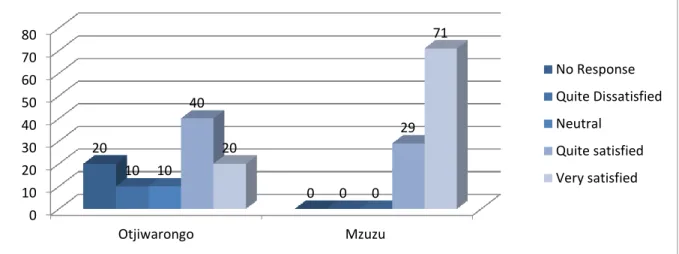
Making sense of city-to-city learning
- Towards a shared understanding of city-to-city learning
- From ‘mentorship’ to ‘learning exchange’
- Who learns and who benefits?
The pragmatic attitude of the research, outlined in the conceptual framework, emerges again. The first question asked in the questionnaire as well as the opening question in each of the in-depth interviews attempted to extract the essence of city-to-city learning. This issue of monitoring and evaluating the impact of city-to-city learning also deserves attention and will be reviewed in the recommendations chapter.
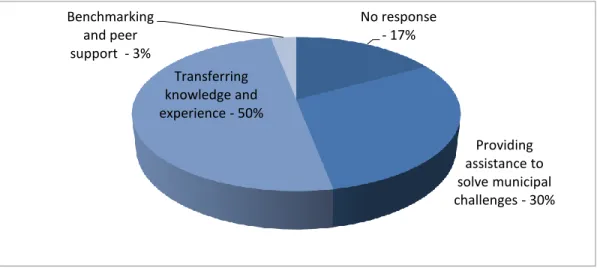
Uncovering the mechanics of city-to-city learning methodologies
This is an important finding that will be considered for inclusion in the development of the learning framework. In order to appreciate most of the city's challenges, they need to be explained in detail. However, as shown in this chapter, not all propositions in the literature hold true for the case study.
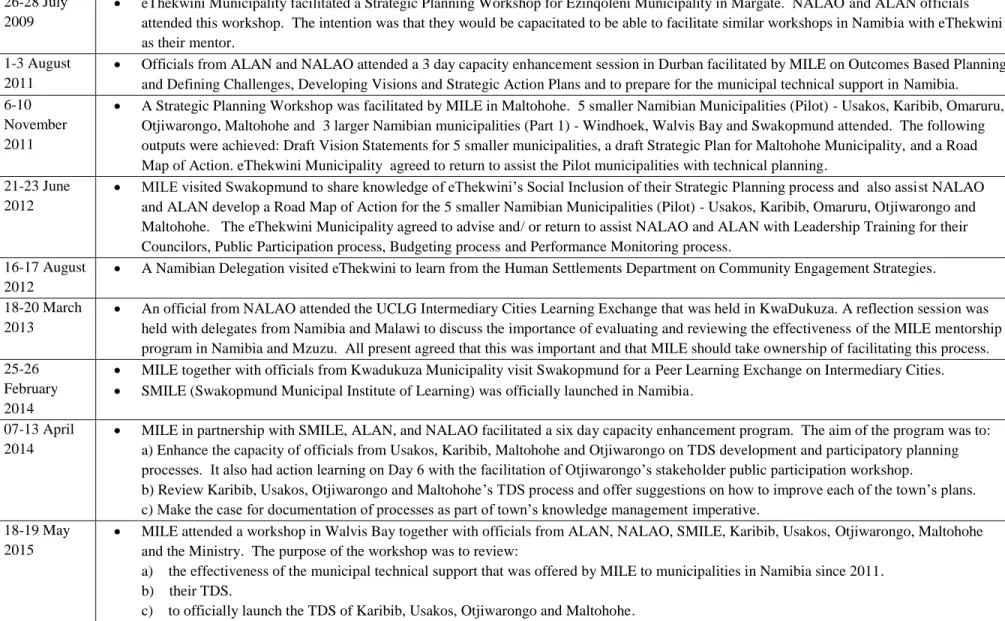
Summary and conclusions
Some of the insights that emerged from the focus group sessions and in-depth interviews have not been documented in Southern Africa and are significant in the process of uncovering the rich, yet underground knowledge economy in city-to-city learning . This corresponds to the orientation of the practice movement and the phronetic research planning tradition referred to in the conceptual framework. It is this aspect of the politics of city-to-city learning that will be considered next.
CHAPTER SIX
DEEPENING THE ANALYSIS: EXPLORING POWER DYNAMICS AND ASSESSING IMPACT OF THE MENTORSHIP PROGRAM
Introduction
Having developed an understanding of power dynamics in the case study, the second part of the chapter is concerned with assessing the value that all interviewees attributed to mentoring and the extent to which it actually improved the quality of the strategic planning process. As stated in Chapter 1, measuring program effectiveness is the third research objective identified in this project. Respondents' perceptions of key factors that may influence mentoring outcomes are also discussed, and interesting findings emerge that offer important insights for future planning practice.
The politics of city-to-city learning: where does the balance of power lie?
When the issue of control and dominance of the learning process was raised with the eThekwini Municipality focus group participants, a robust discussion emerged after further investigation by the researcher. The first position, strongly and very emotionally articulated from a senior official, was that control of the mentoring program rested firmly in the global North, as the program was controlled by the UCLG in Barcelona, Spain. Although this is certainly not part of the scope of the research, it is important to at.
